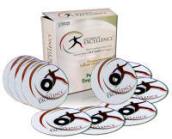US Markets on Uptrend, Some Stocks Breakout
After sitting on the sidelines for the last 3 weeks, while the markets did not provide a clear direction, I started to initiate some new positions last night as the S&P 500 and DoW Jones showed a clear uptrend signal with candles closing above their 50 DMA, 20 EMA above 40 EMA and parabolic SAR below the candles.

I bought half of my intended positions last night as this rally is still not proven to be sustainable yet. I will add to positions as prices move up. I always believe in buying more at higher prices and I never buy more at lower prices (averaging down- that’s just not my style).
For those of you initiating new positions or holding onto positions, start to take note of WHEN your stock is going to report its earnings (can check from google.com/finance) and avoid holding stocks when it announces earnings UNLESS you are really confident that they will not disappoint. Some of my stocks will be reporting in about 2 weeks, so I am in it for a quick kill (hopefully, it does not kill me first ;-))
After the market close, Alcoa (AA) started the US earnings season by reporting better than expected results and providing optimistic guidance for the future. This should continue to give markets a boost moving forward.
The Singapore STI is still on a downtrend so I will definitely not be doing anything on SG stocks for a while. The KLCI is on an uptrend but faces resistance at 1,790 and the parabolic SAR has turned bearish so be careful in entering new positions for KLCI.


My Latest Transactions…
8 July Buy Nokia (NOK) at $4.12 (Stop loss $3.80), Earnings 18 Jul
8 July Buy Nu Skin (NUS) at $64.56 (Stop Loss $56.86), Earnings 22 Jul
8 July Buy Bank of America (BAC) at $13.16 (Stop loss $12.80), Earnings 17 Jul
8 July Sold Sodastream (SODA) at $67.86 for a +20.11% Gain, SODA has been showing weakness despite the index rallying so I sold it even though it is not on a downtrend yet to protect profits .Rather reinvest the funds on stronger performing stocks. Actually,I should have sold it much earlier when price fell more than ATR from its high. I held on because of stupid ‘hope’- damn these human emotions :-).

US Earnings Season- What to Expect
Analysts aren’t expecting much bottom-line or top-line growth for S&P 500 companies.
According to FactSet, the estimated earnings growth rate for the second quarter is 0.8% while the estimated revenue growth rate is 1.2%. Those estimates are down from 4.2% and 2.7%, respectively, at the start of the quarter.
The lowly growth expectations are a function of several factors:
-Weak GDP growth seen around the globe
-The start of the sequestration in the US
-A preponderance of negative guidance from companies issuing guidance (87 out of 108 companies providing guidance issued negative EPS guidance, according to FactSet)
-Falling commodity prices
Is this bad news for the market? Not really. You see, analysts & companies like to play a game where they will always lower expectations ahead of an earnings seasons. This way, the companies can EASILY BEAT earnings and see there company’s share’s rise. Of course once in a while, they really screw up and cannot even beat the lowered expectations.
It is like you son telling you that he will fail his exams very badly. Then, when he gets 63%, you are so happy that you take him out to celebrate. Companies play the same game.
Don’t be surprised, therefore, if the reported EPS growth rate for S&P 500 companies at the end of the reporting period is closer to where it stood at the start of the quarter. The real surprise would be if companies simply matched, or did worse, than the revised growth estimates.
The financial sector, which rolls out its results early in the reporting period, will help set expectations in that regard. Strikingly, it is one of just two sectors (utilities being the other) where EPS growth estimates have gone up, not down, since the start of the quarter. Analysts are expecting the financial sector to deliver 17% EPS growth for the second quarter, making it a key swing factor.
Expected Rise in Interest Rates Will Actually Be Good For Stocks- Especially Banks
Whether you believe that the Fed is going to start withdrawing its stimulus anytime soon or not, the fact is that the market is already pricing in higher interest rates (hence the fall in Bond prices, REITS and high divided stocks).
While some market participants may argue that rising rates will kill the stock market rally, history tells us that the initial phase of rate increase is almost always accompanied by higher stock prices. And the reasons are clear—the increase in rates reflects an improving economy and lower risk of deflation—which are positive for stocks. Chairman Bernanke and many other Fed officials have repeatedly clarified that the gradual withdrawal of stimulus would strictly be economic data dependent. And stocks are the place to be in when the economy improves.
Increase in rates—in particular the initial phase of rise from very low levels—actually indicates that the market now expects a much improved economic picture in the months ahead—a positive scenario for the stock market. Further, bonds lose value when rates rise and so more money will flow into stocks from bonds—another positive for stocks.
Increase in interest rates are bad for stocks only when the central bank raises them to combat inflation, which is not going to be the case anytime in the near future.
Higher rates will result in losses for bond portfolios and will also hurt “bond-like” investments, such as utilities, REITs, telecoms and other high dividend payers which saw a spike in interest earlier this year. Growth/cyclical sectors will benefit significantly from an improving economy.
Higher Interest Rates is Great News for Regional Banks and Insurance Companies
Most banks will benefit in the current environment of rising longer-term rates and low short term interest rates. This causes a steepening of the yield curve.
Short term rates are going to stay at ultra-low levels as long as the Fed maintains its fed funds rate near-zero levels but long-term rates will continue to rise in anticipation of slow-down in the Fed’s bond buying program.
A steepening yield curve improves banks’ net interest margin since they can borrow at very low rates and lend at much higher rates. In addition to a steepening yields curve, an improving earnings picture is also expected to act as a tailwind for banks. US regional banks may actually perform much better than the big banks because they are mostly focused on traditional banking business of deposit taking and lending, whereas bigger banks have many other much more complex activities.
Those of you that may not know which are the best US regional banks to buy can look at ETFs like PowerShares KBW Regional Banking Portfolio ETF (KBWR) and SPDR S&P Regional Banking ETF (KRE).
Insurers also stand to benefit from the rising rate scenario. Many insurance companies—life insurance companies in particular—invest in longer-duration bonds and have thus been hurt by low interest rates. Higher interest rates will enable these companies to earn higher returns on their investment portfolio.SPDR S&P Insurance ETF (KIE) follows the S&P Insurance Select Industry Index and is one I am looking at.

















